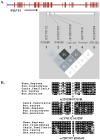Genome-wide association study in Asian populations identifies variants in ETS1 and WDFY4 associated with systemic lupus erythematosus
- PMID: 20169177
- PMCID: PMC2820522
- DOI: 10.1371/journal.pgen.1000841
Genome-wide association study in Asian populations identifies variants in ETS1 and WDFY4 associated with systemic lupus erythematosus
Abstract
Systemic lupus erythematosus is a complex and potentially fatal autoimmune disease, characterized by autoantibody production and multi-organ damage. By a genome-wide association study (320 patients and 1,500 controls) and subsequent replication altogether involving a total of 3,300 Asian SLE patients from Hong Kong, Mainland China, and Thailand, as well as 4,200 ethnically and geographically matched controls, genetic variants in ETS1 and WDFY4 were found to be associated with SLE (ETS1: rs1128334, P = 2.33x10(-11), OR = 1.29; WDFY4: rs7097397, P = 8.15x10(-12), OR = 1.30). ETS1 encodes for a transcription factor known to be involved in a wide range of immune functions, including Th17 cell development and terminal differentiation of B lymphocytes. SNP rs1128334 is located in the 3'-UTR of ETS1, and allelic expression analysis from peripheral blood mononuclear cells showed significantly lower expression level from the risk allele. WDFY4 is a conserved protein with unknown function, but is predominantly expressed in primary and secondary immune tissues, and rs7097397 in WDFY4 changes an arginine residue to glutamine (R1816Q) in this protein. Our study also confirmed association of the HLA locus, STAT4, TNFSF4, BLK, BANK1, IRF5, and TNFAIP3 with SLE in Asians. These new genetic findings may help us to gain a better understanding of the disease and the functions of the genes involved.
Conflict of interest statement
The authors have declared that no competing interests exist.
Figures







Similar articles
-
Gene-gene interactions of IRF5, STAT4, IKZF1 and ETS1 in systemic lupus erythematosus.Tissue Antigens. 2014 Jun;83(6):401-8. doi: 10.1111/tan.12349. Epub 2014 Apr 3. Tissue Antigens. 2014. PMID: 24697319
-
Replicated associations of TNFAIP3, TNIP1 and ETS1 with systemic lupus erythematosus in a southwestern Chinese population.Arthritis Res Ther. 2011;13(6):R186. doi: 10.1186/ar3514. Epub 2011 Nov 16. Arthritis Res Ther. 2011. PMID: 22087647 Free PMC article.
-
E26 transformation-specific-1 (ETS1) and WDFY family member 4 (WDFY4) polymorphisms in Chinese patients with rheumatoid arthritis.Int J Mol Sci. 2014 Feb 17;15(2):2712-21. doi: 10.3390/ijms15022712. Int J Mol Sci. 2014. PMID: 24549174 Free PMC article.
-
Association of IRF5, STAT4 and BLK with systemic lupus erythematosus and other rheumatic diseases.Nihon Rinsho Meneki Gakkai Kaishi. 2010;33(2):57-65. doi: 10.2177/jsci.33.57. Nihon Rinsho Meneki Gakkai Kaishi. 2010. PMID: 20453440 Review.
-
Genetic polymorphisms in genes involved in the type I interferon system (STAT4 and IRF5): association with Asian SLE patients.Clin Rheumatol. 2024 Aug;43(8):2403-2416. doi: 10.1007/s10067-024-07046-8. Epub 2024 Jul 4. Clin Rheumatol. 2024. PMID: 38963465 Review.
Cited by
-
Identification of IRF8, TMEM39A, and IKZF3-ZPBP2 as susceptibility loci for systemic lupus erythematosus in a large-scale multiracial replication study.Am J Hum Genet. 2012 Apr 6;90(4):648-60. doi: 10.1016/j.ajhg.2012.02.023. Epub 2012 Mar 29. Am J Hum Genet. 2012. PMID: 22464253 Free PMC article.
-
Antineutrophil Cytoplasmic Antibody-Associated Vasculitis Update: Genetic Pathogenesis.Front Immunol. 2021 Mar 26;12:624848. doi: 10.3389/fimmu.2021.624848. eCollection 2021. Front Immunol. 2021. PMID: 33841406 Free PMC article. Review.
-
Meta-analysis of genome-wide association study identifies FBN2 as a novel locus associated with systemic lupus erythematosus in Thai population.Arthritis Res Ther. 2020 Aug 8;22(1):185. doi: 10.1186/s13075-020-02276-y. Arthritis Res Ther. 2020. PMID: 32771030 Free PMC article.
-
Bias in effect size of systemic lupus erythematosus susceptibility loci across Europe: a case-control study.Arthritis Res Ther. 2012 Apr 27;14(2):R94. doi: 10.1186/ar3818. Arthritis Res Ther. 2012. PMID: 22541939 Free PMC article.
-
Genetic association of E26 transformation specific sequence 1 polymorphisms with the susceptibility of primary biliary cholangitis in China.Sci Rep. 2019 Dec 23;9(1):19680. doi: 10.1038/s41598-019-56181-9. Sci Rep. 2019. PMID: 31873148 Free PMC article.
References
-
- Sestak AL, Shaver TS, Moser KL, Neas BR, Harley JB. Familial aggregation of lupus and autoimmunity in an unusual multiplex pedigree. J Rheumatol. 1999;26:1495–1499. - PubMed
-
- Ramos-Niembro F, Alarcon-Segovia D. Familial aspects of mixed connective tissue disease (MCTD). I. Occurrence of systemic lupus erythematosus in another member in two families and aggregation of MCTD in another family. J Rheumatol. 1978;5:433–440. - PubMed
-
- Arnett FC, Shulman LE. Studies in familial systemic lupus erythematosus. Medicine (Baltimore) 1976;55:313–322. - PubMed
-
- Mok CC, Lau CS. Lupus in Hong Kong Chinese. Lupus. 2003;12:717–722. - PubMed
-
- Wong SN, Tse KC, Lee TL, Lee KW, Chim S, et al. Lupus nephritis in Chinese children–a territory-wide cohort study in Hong Kong. Pediatr Nephrol. 2006;21:1104–1112. - PubMed
Publication types
MeSH terms
Substances
LinkOut - more resources
Full Text Sources
Other Literature Sources
Medical
Research Materials
Miscellaneous

